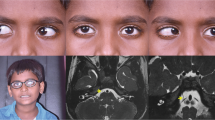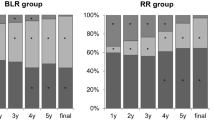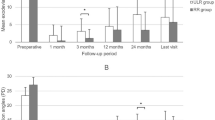Abstract
Purpose
The tendon width of the lateral rectus muscle is known to be a useful indicator for estimation of the effect of lateral rectus recession in intermittent exotropia. This study was conducted to investigate whether the tendon width of the lateral rectus would differ according to different age groups.
Patients and methods
We studied 133 patients ranging from 0 to 51 years of age who had undergone bilateral lateral rectus (BLR) recession for the basic type of intermittent exotropia. A total of 133 patients were divided into four groups; 16 patients who were younger than 2 years old (group 1), 20 patients who were 2–5 years old (group 2), 75 patients who were 5–13 years old (group 3), and 22 patients who were older than 13 years (group 4). Under general anesthesia and before dissection of the muscle tendon from the sclera, the tendon width of the lateral rectus of both eyes near insertion was measured with calipers.
Results
The tendon width of each group was as follows: in group 1, 7.84±0.35 mm in the right eye and 7.66±0.44 mm in the left eye; in group 2, 7.70±0.50 mm and 7.65±0.52; in group 3 8.11±0.36, 7.95±0.48. In group 4, measurements were 8.14±0.49 mm and 8.05±0.38 mm, respectively. The difference of tendon width in both eyes was statistically significant in all four groups (P<0.01) and the tendon widths of group 1 and 2 were narrower than that of group 3 and 4.
Conclusion
Measurement of tendon width of the lateral rectus muscle for prediction of the effect in intermittent exotropia should be applied in patients ≥5 years of age.
Similar content being viewed by others
Introduction
The tendon width of the lateral rectus has been reported to be a useful indicator for estimation of the effect of lateral rectus recession in intermittent exotropia.1, 2 The mean effect of 1 mm lateral rectus recession has been shown to range from 2.7 to 3.5 preoperative deviation (PD) according to tendon width and the effect of recession has been shown to be larger in cases in which the lateral rectus tendon width is narrower because the tendon width might speak for muscle hypertrophy or contracture from increased innervation on the lateral rectus muscles in exotropia.1, 3 One of the authors (SK) previously reported this finding in patients aged from 3 to 15, who underwent unilateral or bilateral lateral rectus (BLR) recession for the basic type of intermittent exotropia.2
However, authors were afraid of the possibility of the tendon width of the lateral rectus muscle being an artifact that reflects a growth pattern of an eyeball component. The aim of this study was to investigate whether the tendon width of the lateral rectus would differ in exotropia patients in different age groups.
Patients and methods
This study investigated consecutive patients who underwent BLR recession for intermittent exotropia by a single surgeon (SK). We studied 133 patients (266 eyes) ranging from 0 to 51 years of age who had undergone BLR recession for the basic type of intermittent exotropia. Institutional Review Board approval for this study was obtained from Korea University Medical Center. All research and data collection followed the tenets of the Helsinki agreement.
Patients were divided into four groups; 16 patients who were younger than 2 years old (group 1), 20 patients who were 2–5 years old (group 2), 75 patients who were 5–13 years old (group 3), and 22 patients who were older than 13 years (group 4).
Under general anesthesia and before dissection of the muscle tendon from the sclera, the tendon width of the lateral rectus near insertion was measured with calipers.
Statistical analysis
ANOVA test, Duncan's multiple range test were used to compare tendon widths of different age groups. Multiple regression analysis with stepwise variable selection was carried out to identify factors significantly contributing to tendon width. The comparison of tendon width according to gender was carried out with independent t-test. Statistical calculations were performed using the Statistical Program for the Social Sciences (SPSS Inc., Chicago, IL, USA) software package. A value of P<0.05 was considered statistically significant.
Results
In all, 133 patients were divided into four groups; 16 patients who were younger than 2 years old (group 1), 20 patients who were 2–5 years old (group 2), 75 patients who were 5–13 years old (group 3), and 22 patients who were older than 13 years (group 4). There was no significant difference of PD angle among groups (Table 1).
Overall mean lateral rectus tendon widths were 8.02 mm in the right eye and 7.85 mm in the left eye (range: 7–9.5 mm). In group 1, the average tendon width was 7.84±0.35 mm in the right eye and 7.66±0.44 mm in the left eye, 7.70±0.50 mm and 7.65±0.52 in each eye in group 2, 8.11±0.36, 7.95±0.48 in each eye in group 3, and 8.14±0.49, 8.05±0.38, respectively, in group 4. Mean tendon widths of both eyes were 7.75±0.34 in group 1, 7.68±0.42 in group 2, 8.01±0.39 in group 3 and 8.06±0.45 in group 4.
The difference of tendon width in both eyes was statistically significant in all four groups (P<0.01 by ANOVA test; Table 2). The Duncan’s multiple range test showed that the tendon width of group 1 and 2 was narrower than that of group 3 and 4 (P<0.05; Table 2).
To assess the effect of parameters, the stepwise multiple regression analysis was carried out and the result showed that only age was correlated to tendon width (P=0.04, R2=0.03; Table 3 & Figure 1). Mean tendon width of both right and left eye was 7.91±4.49 in male group and 7.96±0.39 in female group. There was no difference of tendon width according to gender (P=0.43; Table 4).
Discussion
Owing to high rate of undercorrection, there is a tendency toward exotropic drift over time.
Overcorrection of exotropia in the early postoperative period could lead to the best long-term results for intermittent exotropia.4, 5
Therefore, a large number of strabismus surgeons have considered many factors to facilitate the appropriate amount of overcorrection in the early postoperative period. One of the authors has reported that the tendon width of the lateral rectus muscle can be a useful indicator for estimation of the effect of unilateral lateral rectus recession and BLR rectus recession if the preoperative exodeviation is below 25 PD in intermittent exotropia.1, 2
The human eye undergoes dramatic anatomical and physiological development throughout infancy and early childhood.6 Most growth of the eye takes place during the first year of life and the change occurs in three phases. The first phase is a rapid postnatal growth phase during the first 18 months of life. During the second phase (age 2–5 years), and a slower third (age 5–13 years) phase, the eye grows.6 According to this growth pattern, we divided patients into four groups: group 1 (patients who were under 2 years old), group 2 (patients who were between 2 and 5 years old), group 3 (patients who were between 5 and 13 years old), and group 4 (patients who were older than 13 years). We believe the patients in group 1 were classified into infantile intermittent exotropia.7, 8, 9 In this study, tendon widths of patients under 5 years old were narrower than those of other groups. However, no statistically significant difference was observed between groups who were 5–13 years old and older than 13 years old. This finding can reflect a growth pattern of an eyeball component.
Similar to other ocular structures, the extraocular muscles undergo significant anatomic change during infancy. In a study of 26 infant eyes by Swan and Wilkins,6 widths of rectus muscle insertions in neonates were roughly 2.5–3 mm narrower than those in adults on average; however, there was a great deal of individual variation. They also reported that the tendons appeared to be much thinner and more easily disinserted than those of adult rectus muscles. Finally, the rectus muscles were adult-like in dimension by the age of 20 months. In this study, tendon widths of group 1 and 2 were narrower than group 3 and 4. No statistically significant differences in tendon widths were observed between group 1 (patients who were under 2 years old) and 2 (patients who were between 2 and 5 years old).
Therefore, we can conclude that rectus muscle dimensions could be adult-like by 20 months of age; however, additional expansion may occur up to 5 years of age from this study.
The stepwise multiple regression analysis revealed that age was the only factor that can affect tendon width (P=0.04), but its coefficient of determination is very low to explain the relationship (R2=0.03). In addition, comparison of tendon width according to gender showed that tendon widths of male group were narrower than those of female group but no statistically significant difference was observed.
Considering the growth pattern of an eyeball, application of tendon width for estimation of the effect of lateral rectus recession in patients younger than 5 years of age with intermittent exotropia was not appropriate in this study. Therefore, measurement of tendon width of the lateral rectus muscle for prediction of the effect in intermittent exotropia should be applied in patients 5 years of age or older.

References
Kim SH, Choi YJ . Effects of unilateral rectus recession according to the tendon width in intermittent exotropia. Eye 2006; 20: 785–788.
Lee H, Kim SH . Bilateral lateral rectus recession considering the tendon width in intermittent exotropia. Eye 2009; 23: 1808–1811.
Jasman W, Jaeger EA . Concomitant exodeviation. In: Parks MM, Mitchell PR (eds). Duane's Clinical Ophthalmology. JB Lippincott company: Philadelphia, 1, Chapter 13, 1991.
Raab EL, Parks MM . Recession of the lateral recti: early and late postoperative alignment. Arch Ophthalmol 1969; 82: 203–208.
Scott WE, Keech R, Marsh AJ . The postoperative results and stability of exodeviation. Arch Ophthalmol 1981; 99: 1814–1818.
Swan KC, Wilkins JH . Extraocular muscle surgery in early infancy-anatomical factors. J Pediatr Ophthalmol Strabismus 1984; 21: 44–49.
Hunter DG, Kelly JB, Buffenn AN et al. Long-term outcome of uncomplicated infantile exotropia. J AAPOS 2001; 5: 352–356.
Biglan AW, Davis JS, Cheng KP, Pettapiece MC . Infantile exotropia. J Pediatr Ophthalmol Strabismus 1996; 33: 79–84.
Park JH, Kim SH . Clinical features and the risk factors of infantile exotropia recurrence. Am J Ophthalmol. 2010; 150 (4): 464–467.
Acknowledgements
We thank to Soonyoung Hwang, PhD, Biostatistician, Korea University College of Medicine, Department of Biostatistics, for her help with statistical analysis and technical editing of this study.
Author information
Authors and Affiliations
Corresponding author
Ethics declarations
Competing interests
The authors declare no conflict of interest.
Rights and permissions
About this article
Cite this article
Yun, CM., Kim, SH. The tendon width of lateral rectus muscle in predicting the effect of recession: is it just age-related artifact?. Eye 25, 1356–1359 (2011). https://doi.org/10.1038/eye.2011.178
Received:
Revised:
Accepted:
Published:
Issue Date:
DOI: https://doi.org/10.1038/eye.2011.178
Keywords
This article is cited by
-
Binocular discrepancy in lateral rectus muscle attachment in intermittent exotropia with eye dominance
Graefe's Archive for Clinical and Experimental Ophthalmology (2020)
-
Intermittent exotropia: relation between age and surgical outcome: a change-point analysis
Eye (2014)




